What do we Mean by Risk and Resilience
VerifiedAdded on 2022/08/14
|10
|3659
|14
AI Summary
Please follow the file and the total words 2400 excluding reference
Contribute Materials
Your contribution can guide someone’s learning journey. Share your
documents today.
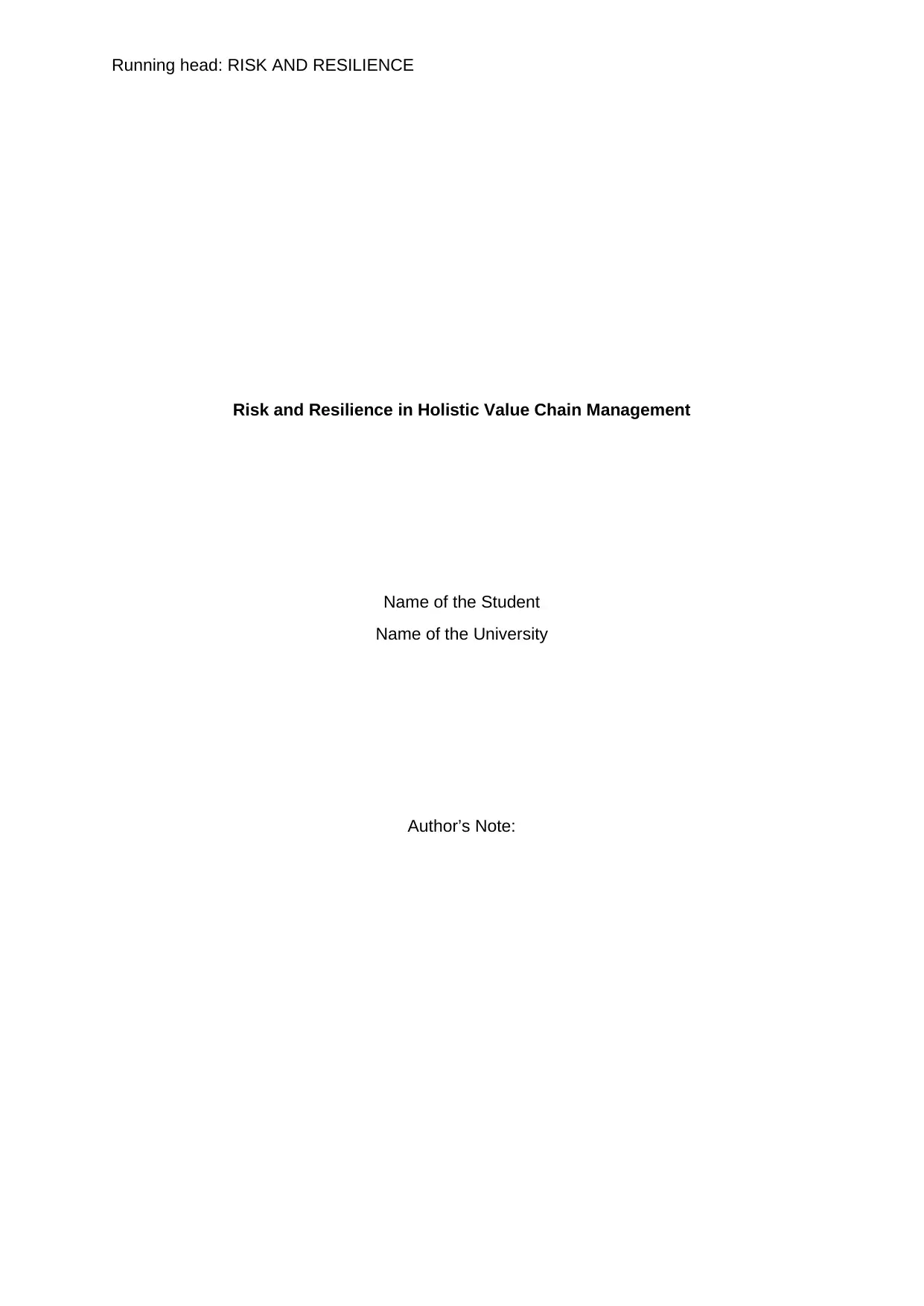
Running head: RISK AND RESILIENCE
Risk and Resilience in Holistic Value Chain Management
Name of the Student
Name of the University
Author’s Note:
Risk and Resilience in Holistic Value Chain Management
Name of the Student
Name of the University
Author’s Note:
Secure Best Marks with AI Grader
Need help grading? Try our AI Grader for instant feedback on your assignments.
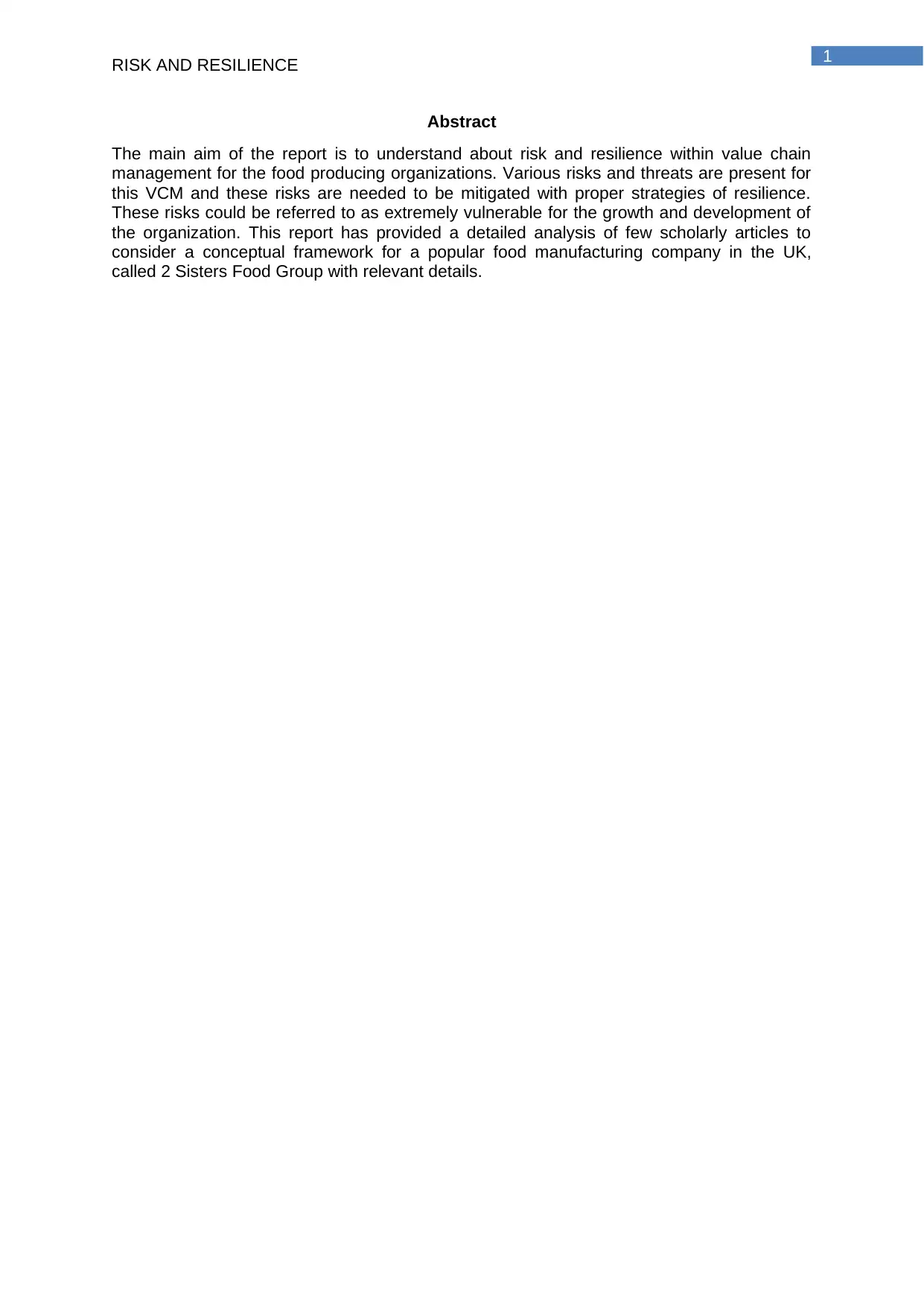
1
RISK AND RESILIENCE
Abstract
The main aim of the report is to understand about risk and resilience within value chain
management for the food producing organizations. Various risks and threats are present for
this VCM and these risks are needed to be mitigated with proper strategies of resilience.
These risks could be referred to as extremely vulnerable for the growth and development of
the organization. This report has provided a detailed analysis of few scholarly articles to
consider a conceptual framework for a popular food manufacturing company in the UK,
called 2 Sisters Food Group with relevant details.
RISK AND RESILIENCE
Abstract
The main aim of the report is to understand about risk and resilience within value chain
management for the food producing organizations. Various risks and threats are present for
this VCM and these risks are needed to be mitigated with proper strategies of resilience.
These risks could be referred to as extremely vulnerable for the growth and development of
the organization. This report has provided a detailed analysis of few scholarly articles to
consider a conceptual framework for a popular food manufacturing company in the UK,
called 2 Sisters Food Group with relevant details.
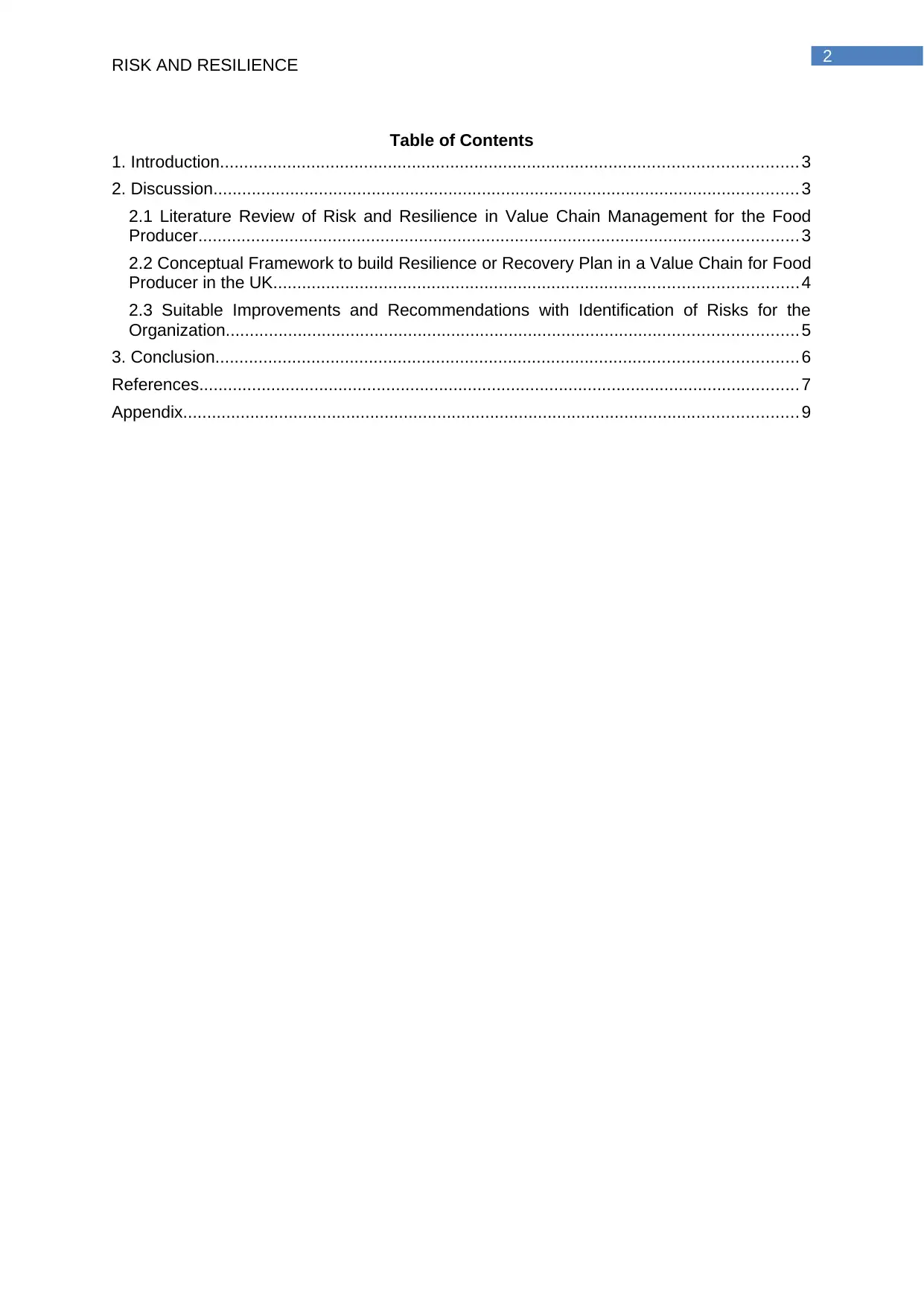
2
RISK AND RESILIENCE
Table of Contents
1. Introduction........................................................................................................................ 3
2. Discussion.......................................................................................................................... 3
2.1 Literature Review of Risk and Resilience in Value Chain Management for the Food
Producer............................................................................................................................. 3
2.2 Conceptual Framework to build Resilience or Recovery Plan in a Value Chain for Food
Producer in the UK.............................................................................................................4
2.3 Suitable Improvements and Recommendations with Identification of Risks for the
Organization....................................................................................................................... 5
3. Conclusion......................................................................................................................... 6
References............................................................................................................................. 7
Appendix................................................................................................................................ 9
RISK AND RESILIENCE
Table of Contents
1. Introduction........................................................................................................................ 3
2. Discussion.......................................................................................................................... 3
2.1 Literature Review of Risk and Resilience in Value Chain Management for the Food
Producer............................................................................................................................. 3
2.2 Conceptual Framework to build Resilience or Recovery Plan in a Value Chain for Food
Producer in the UK.............................................................................................................4
2.3 Suitable Improvements and Recommendations with Identification of Risks for the
Organization....................................................................................................................... 5
3. Conclusion......................................................................................................................... 6
References............................................................................................................................. 7
Appendix................................................................................................................................ 9
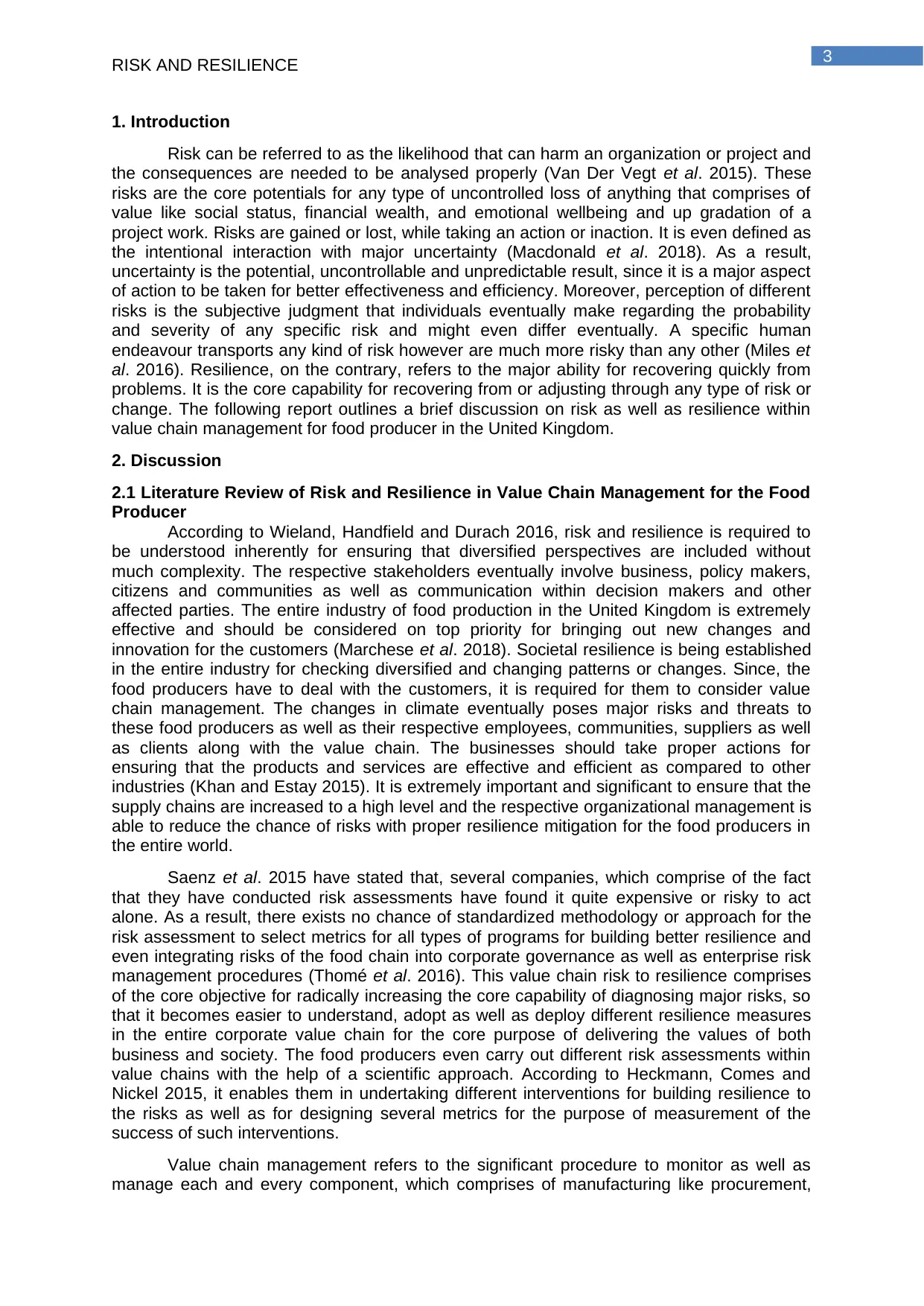
3
RISK AND RESILIENCE
1. Introduction
Risk can be referred to as the likelihood that can harm an organization or project and
the consequences are needed to be analysed properly (Van Der Vegt et al. 2015). These
risks are the core potentials for any type of uncontrolled loss of anything that comprises of
value like social status, financial wealth, and emotional wellbeing and up gradation of a
project work. Risks are gained or lost, while taking an action or inaction. It is even defined as
the intentional interaction with major uncertainty (Macdonald et al. 2018). As a result,
uncertainty is the potential, uncontrollable and unpredictable result, since it is a major aspect
of action to be taken for better effectiveness and efficiency. Moreover, perception of different
risks is the subjective judgment that individuals eventually make regarding the probability
and severity of any specific risk and might even differ eventually. A specific human
endeavour transports any kind of risk however are much more risky than any other (Miles et
al. 2016). Resilience, on the contrary, refers to the major ability for recovering quickly from
problems. It is the core capability for recovering from or adjusting through any type of risk or
change. The following report outlines a brief discussion on risk as well as resilience within
value chain management for food producer in the United Kingdom.
2. Discussion
2.1 Literature Review of Risk and Resilience in Value Chain Management for the Food
Producer
According to Wieland, Handfield and Durach 2016, risk and resilience is required to
be understood inherently for ensuring that diversified perspectives are included without
much complexity. The respective stakeholders eventually involve business, policy makers,
citizens and communities as well as communication within decision makers and other
affected parties. The entire industry of food production in the United Kingdom is extremely
effective and should be considered on top priority for bringing out new changes and
innovation for the customers (Marchese et al. 2018). Societal resilience is being established
in the entire industry for checking diversified and changing patterns or changes. Since, the
food producers have to deal with the customers, it is required for them to consider value
chain management. The changes in climate eventually poses major risks and threats to
these food producers as well as their respective employees, communities, suppliers as well
as clients along with the value chain. The businesses should take proper actions for
ensuring that the products and services are effective and efficient as compared to other
industries (Khan and Estay 2015). It is extremely important and significant to ensure that the
supply chains are increased to a high level and the respective organizational management is
able to reduce the chance of risks with proper resilience mitigation for the food producers in
the entire world.
Saenz et al. 2015 have stated that, several companies, which comprise of the fact
that they have conducted risk assessments have found it quite expensive or risky to act
alone. As a result, there exists no chance of standardized methodology or approach for the
risk assessment to select metrics for all types of programs for building better resilience and
even integrating risks of the food chain into corporate governance as well as enterprise risk
management procedures (Thomé et al. 2016). This value chain risk to resilience comprises
of the core objective for radically increasing the core capability of diagnosing major risks, so
that it becomes easier to understand, adopt as well as deploy different resilience measures
in the entire corporate value chain for the core purpose of delivering the values of both
business and society. The food producers even carry out different risk assessments within
value chains with the help of a scientific approach. According to Heckmann, Comes and
Nickel 2015, it enables them in undertaking different interventions for building resilience to
the risks as well as for designing several metrics for the purpose of measurement of the
success of such interventions.
Value chain management refers to the significant procedure to monitor as well as
manage each and every component, which comprises of manufacturing like procurement,
RISK AND RESILIENCE
1. Introduction
Risk can be referred to as the likelihood that can harm an organization or project and
the consequences are needed to be analysed properly (Van Der Vegt et al. 2015). These
risks are the core potentials for any type of uncontrolled loss of anything that comprises of
value like social status, financial wealth, and emotional wellbeing and up gradation of a
project work. Risks are gained or lost, while taking an action or inaction. It is even defined as
the intentional interaction with major uncertainty (Macdonald et al. 2018). As a result,
uncertainty is the potential, uncontrollable and unpredictable result, since it is a major aspect
of action to be taken for better effectiveness and efficiency. Moreover, perception of different
risks is the subjective judgment that individuals eventually make regarding the probability
and severity of any specific risk and might even differ eventually. A specific human
endeavour transports any kind of risk however are much more risky than any other (Miles et
al. 2016). Resilience, on the contrary, refers to the major ability for recovering quickly from
problems. It is the core capability for recovering from or adjusting through any type of risk or
change. The following report outlines a brief discussion on risk as well as resilience within
value chain management for food producer in the United Kingdom.
2. Discussion
2.1 Literature Review of Risk and Resilience in Value Chain Management for the Food
Producer
According to Wieland, Handfield and Durach 2016, risk and resilience is required to
be understood inherently for ensuring that diversified perspectives are included without
much complexity. The respective stakeholders eventually involve business, policy makers,
citizens and communities as well as communication within decision makers and other
affected parties. The entire industry of food production in the United Kingdom is extremely
effective and should be considered on top priority for bringing out new changes and
innovation for the customers (Marchese et al. 2018). Societal resilience is being established
in the entire industry for checking diversified and changing patterns or changes. Since, the
food producers have to deal with the customers, it is required for them to consider value
chain management. The changes in climate eventually poses major risks and threats to
these food producers as well as their respective employees, communities, suppliers as well
as clients along with the value chain. The businesses should take proper actions for
ensuring that the products and services are effective and efficient as compared to other
industries (Khan and Estay 2015). It is extremely important and significant to ensure that the
supply chains are increased to a high level and the respective organizational management is
able to reduce the chance of risks with proper resilience mitigation for the food producers in
the entire world.
Saenz et al. 2015 have stated that, several companies, which comprise of the fact
that they have conducted risk assessments have found it quite expensive or risky to act
alone. As a result, there exists no chance of standardized methodology or approach for the
risk assessment to select metrics for all types of programs for building better resilience and
even integrating risks of the food chain into corporate governance as well as enterprise risk
management procedures (Thomé et al. 2016). This value chain risk to resilience comprises
of the core objective for radically increasing the core capability of diagnosing major risks, so
that it becomes easier to understand, adopt as well as deploy different resilience measures
in the entire corporate value chain for the core purpose of delivering the values of both
business and society. The food producers even carry out different risk assessments within
value chains with the help of a scientific approach. According to Heckmann, Comes and
Nickel 2015, it enables them in undertaking different interventions for building resilience to
the risks as well as for designing several metrics for the purpose of measurement of the
success of such interventions.
Value chain management refers to the significant procedure to monitor as well as
manage each and every component, which comprises of manufacturing like procurement,
Secure Best Marks with AI Grader
Need help grading? Try our AI Grader for instant feedback on your assignments.
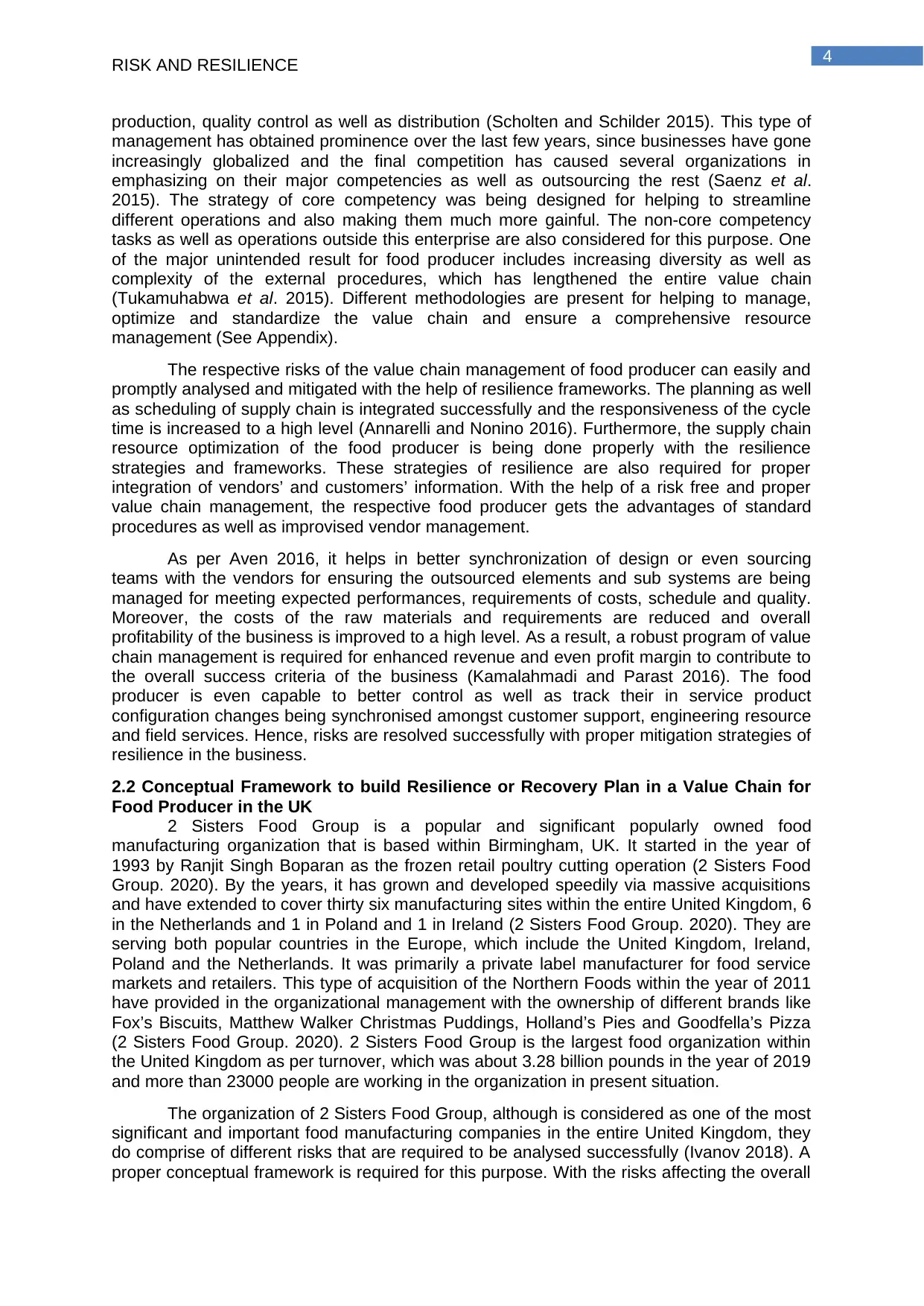
4
RISK AND RESILIENCE
production, quality control as well as distribution (Scholten and Schilder 2015). This type of
management has obtained prominence over the last few years, since businesses have gone
increasingly globalized and the final competition has caused several organizations in
emphasizing on their major competencies as well as outsourcing the rest (Saenz et al.
2015). The strategy of core competency was being designed for helping to streamline
different operations and also making them much more gainful. The non-core competency
tasks as well as operations outside this enterprise are also considered for this purpose. One
of the major unintended result for food producer includes increasing diversity as well as
complexity of the external procedures, which has lengthened the entire value chain
(Tukamuhabwa et al. 2015). Different methodologies are present for helping to manage,
optimize and standardize the value chain and ensure a comprehensive resource
management (See Appendix).
The respective risks of the value chain management of food producer can easily and
promptly analysed and mitigated with the help of resilience frameworks. The planning as well
as scheduling of supply chain is integrated successfully and the responsiveness of the cycle
time is increased to a high level (Annarelli and Nonino 2016). Furthermore, the supply chain
resource optimization of the food producer is being done properly with the resilience
strategies and frameworks. These strategies of resilience are also required for proper
integration of vendors’ and customers’ information. With the help of a risk free and proper
value chain management, the respective food producer gets the advantages of standard
procedures as well as improvised vendor management.
As per Aven 2016, it helps in better synchronization of design or even sourcing
teams with the vendors for ensuring the outsourced elements and sub systems are being
managed for meeting expected performances, requirements of costs, schedule and quality.
Moreover, the costs of the raw materials and requirements are reduced and overall
profitability of the business is improved to a high level. As a result, a robust program of value
chain management is required for enhanced revenue and even profit margin to contribute to
the overall success criteria of the business (Kamalahmadi and Parast 2016). The food
producer is even capable to better control as well as track their in service product
configuration changes being synchronised amongst customer support, engineering resource
and field services. Hence, risks are resolved successfully with proper mitigation strategies of
resilience in the business.
2.2 Conceptual Framework to build Resilience or Recovery Plan in a Value Chain for
Food Producer in the UK
2 Sisters Food Group is a popular and significant popularly owned food
manufacturing organization that is based within Birmingham, UK. It started in the year of
1993 by Ranjit Singh Boparan as the frozen retail poultry cutting operation (2 Sisters Food
Group. 2020). By the years, it has grown and developed speedily via massive acquisitions
and have extended to cover thirty six manufacturing sites within the entire United Kingdom, 6
in the Netherlands and 1 in Poland and 1 in Ireland (2 Sisters Food Group. 2020). They are
serving both popular countries in the Europe, which include the United Kingdom, Ireland,
Poland and the Netherlands. It was primarily a private label manufacturer for food service
markets and retailers. This type of acquisition of the Northern Foods within the year of 2011
have provided in the organizational management with the ownership of different brands like
Fox’s Biscuits, Matthew Walker Christmas Puddings, Holland’s Pies and Goodfella’s Pizza
(2 Sisters Food Group. 2020). 2 Sisters Food Group is the largest food organization within
the United Kingdom as per turnover, which was about 3.28 billion pounds in the year of 2019
and more than 23000 people are working in the organization in present situation.
The organization of 2 Sisters Food Group, although is considered as one of the most
significant and important food manufacturing companies in the entire United Kingdom, they
do comprise of different risks that are required to be analysed successfully (Ivanov 2018). A
proper conceptual framework is required for this purpose. With the risks affecting the overall
RISK AND RESILIENCE
production, quality control as well as distribution (Scholten and Schilder 2015). This type of
management has obtained prominence over the last few years, since businesses have gone
increasingly globalized and the final competition has caused several organizations in
emphasizing on their major competencies as well as outsourcing the rest (Saenz et al.
2015). The strategy of core competency was being designed for helping to streamline
different operations and also making them much more gainful. The non-core competency
tasks as well as operations outside this enterprise are also considered for this purpose. One
of the major unintended result for food producer includes increasing diversity as well as
complexity of the external procedures, which has lengthened the entire value chain
(Tukamuhabwa et al. 2015). Different methodologies are present for helping to manage,
optimize and standardize the value chain and ensure a comprehensive resource
management (See Appendix).
The respective risks of the value chain management of food producer can easily and
promptly analysed and mitigated with the help of resilience frameworks. The planning as well
as scheduling of supply chain is integrated successfully and the responsiveness of the cycle
time is increased to a high level (Annarelli and Nonino 2016). Furthermore, the supply chain
resource optimization of the food producer is being done properly with the resilience
strategies and frameworks. These strategies of resilience are also required for proper
integration of vendors’ and customers’ information. With the help of a risk free and proper
value chain management, the respective food producer gets the advantages of standard
procedures as well as improvised vendor management.
As per Aven 2016, it helps in better synchronization of design or even sourcing
teams with the vendors for ensuring the outsourced elements and sub systems are being
managed for meeting expected performances, requirements of costs, schedule and quality.
Moreover, the costs of the raw materials and requirements are reduced and overall
profitability of the business is improved to a high level. As a result, a robust program of value
chain management is required for enhanced revenue and even profit margin to contribute to
the overall success criteria of the business (Kamalahmadi and Parast 2016). The food
producer is even capable to better control as well as track their in service product
configuration changes being synchronised amongst customer support, engineering resource
and field services. Hence, risks are resolved successfully with proper mitigation strategies of
resilience in the business.
2.2 Conceptual Framework to build Resilience or Recovery Plan in a Value Chain for
Food Producer in the UK
2 Sisters Food Group is a popular and significant popularly owned food
manufacturing organization that is based within Birmingham, UK. It started in the year of
1993 by Ranjit Singh Boparan as the frozen retail poultry cutting operation (2 Sisters Food
Group. 2020). By the years, it has grown and developed speedily via massive acquisitions
and have extended to cover thirty six manufacturing sites within the entire United Kingdom, 6
in the Netherlands and 1 in Poland and 1 in Ireland (2 Sisters Food Group. 2020). They are
serving both popular countries in the Europe, which include the United Kingdom, Ireland,
Poland and the Netherlands. It was primarily a private label manufacturer for food service
markets and retailers. This type of acquisition of the Northern Foods within the year of 2011
have provided in the organizational management with the ownership of different brands like
Fox’s Biscuits, Matthew Walker Christmas Puddings, Holland’s Pies and Goodfella’s Pizza
(2 Sisters Food Group. 2020). 2 Sisters Food Group is the largest food organization within
the United Kingdom as per turnover, which was about 3.28 billion pounds in the year of 2019
and more than 23000 people are working in the organization in present situation.
The organization of 2 Sisters Food Group, although is considered as one of the most
significant and important food manufacturing companies in the entire United Kingdom, they
do comprise of different risks that are required to be analysed successfully (Ivanov 2018). A
proper conceptual framework is required for this purpose. With the risks affecting the overall
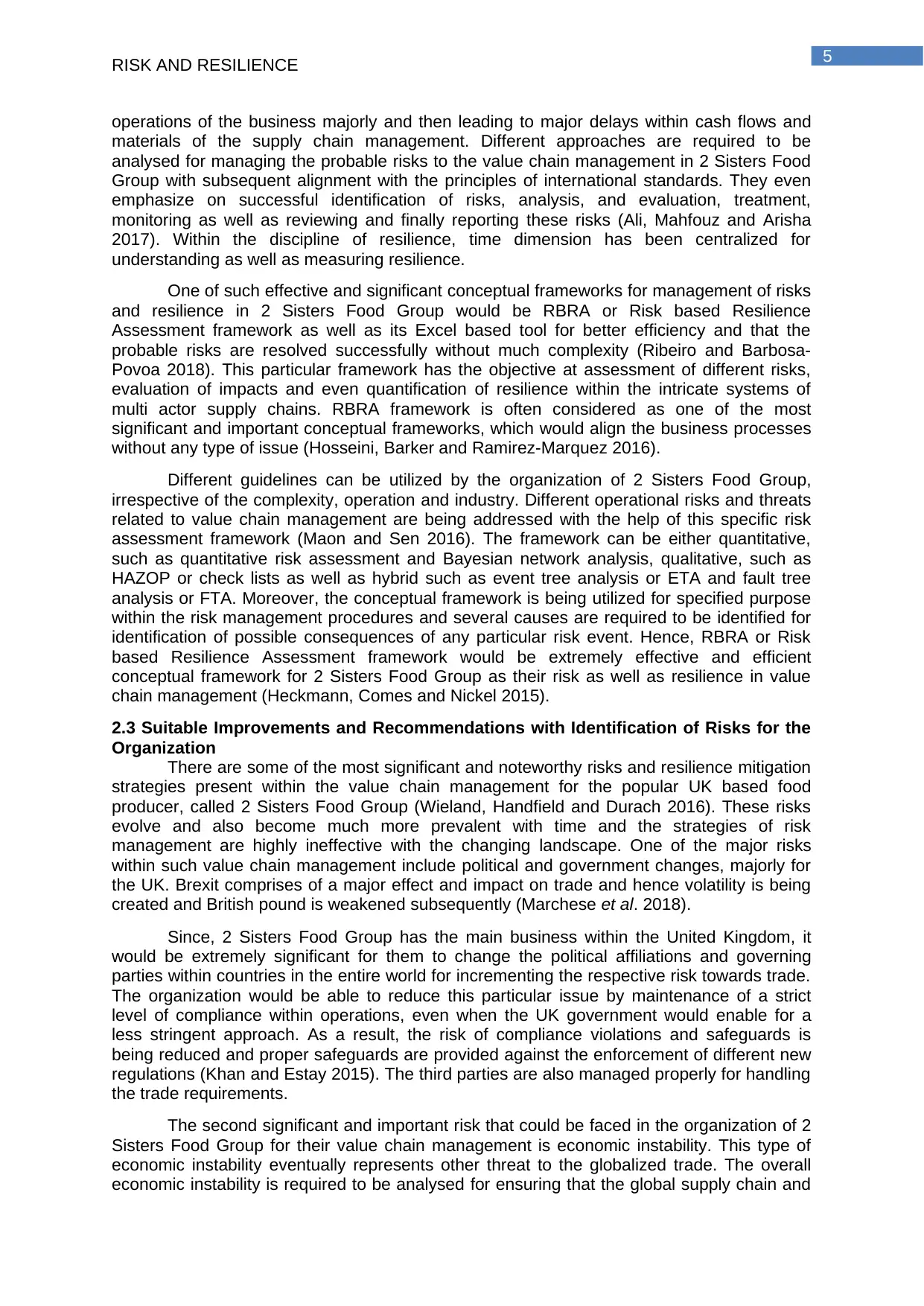
5
RISK AND RESILIENCE
operations of the business majorly and then leading to major delays within cash flows and
materials of the supply chain management. Different approaches are required to be
analysed for managing the probable risks to the value chain management in 2 Sisters Food
Group with subsequent alignment with the principles of international standards. They even
emphasize on successful identification of risks, analysis, and evaluation, treatment,
monitoring as well as reviewing and finally reporting these risks (Ali, Mahfouz and Arisha
2017). Within the discipline of resilience, time dimension has been centralized for
understanding as well as measuring resilience.
One of such effective and significant conceptual frameworks for management of risks
and resilience in 2 Sisters Food Group would be RBRA or Risk based Resilience
Assessment framework as well as its Excel based tool for better efficiency and that the
probable risks are resolved successfully without much complexity (Ribeiro and Barbosa-
Povoa 2018). This particular framework has the objective at assessment of different risks,
evaluation of impacts and even quantification of resilience within the intricate systems of
multi actor supply chains. RBRA framework is often considered as one of the most
significant and important conceptual frameworks, which would align the business processes
without any type of issue (Hosseini, Barker and Ramirez-Marquez 2016).
Different guidelines can be utilized by the organization of 2 Sisters Food Group,
irrespective of the complexity, operation and industry. Different operational risks and threats
related to value chain management are being addressed with the help of this specific risk
assessment framework (Maon and Sen 2016). The framework can be either quantitative,
such as quantitative risk assessment and Bayesian network analysis, qualitative, such as
HAZOP or check lists as well as hybrid such as event tree analysis or ETA and fault tree
analysis or FTA. Moreover, the conceptual framework is being utilized for specified purpose
within the risk management procedures and several causes are required to be identified for
identification of possible consequences of any particular risk event. Hence, RBRA or Risk
based Resilience Assessment framework would be extremely effective and efficient
conceptual framework for 2 Sisters Food Group as their risk as well as resilience in value
chain management (Heckmann, Comes and Nickel 2015).
2.3 Suitable Improvements and Recommendations with Identification of Risks for the
Organization
There are some of the most significant and noteworthy risks and resilience mitigation
strategies present within the value chain management for the popular UK based food
producer, called 2 Sisters Food Group (Wieland, Handfield and Durach 2016). These risks
evolve and also become much more prevalent with time and the strategies of risk
management are highly ineffective with the changing landscape. One of the major risks
within such value chain management include political and government changes, majorly for
the UK. Brexit comprises of a major effect and impact on trade and hence volatility is being
created and British pound is weakened subsequently (Marchese et al. 2018).
Since, 2 Sisters Food Group has the main business within the United Kingdom, it
would be extremely significant for them to change the political affiliations and governing
parties within countries in the entire world for incrementing the respective risk towards trade.
The organization would be able to reduce this particular issue by maintenance of a strict
level of compliance within operations, even when the UK government would enable for a
less stringent approach. As a result, the risk of compliance violations and safeguards is
being reduced and proper safeguards are provided against the enforcement of different new
regulations (Khan and Estay 2015). The third parties are also managed properly for handling
the trade requirements.
The second significant and important risk that could be faced in the organization of 2
Sisters Food Group for their value chain management is economic instability. This type of
economic instability eventually represents other threat to the globalized trade. The overall
economic instability is required to be analysed for ensuring that the global supply chain and
RISK AND RESILIENCE
operations of the business majorly and then leading to major delays within cash flows and
materials of the supply chain management. Different approaches are required to be
analysed for managing the probable risks to the value chain management in 2 Sisters Food
Group with subsequent alignment with the principles of international standards. They even
emphasize on successful identification of risks, analysis, and evaluation, treatment,
monitoring as well as reviewing and finally reporting these risks (Ali, Mahfouz and Arisha
2017). Within the discipline of resilience, time dimension has been centralized for
understanding as well as measuring resilience.
One of such effective and significant conceptual frameworks for management of risks
and resilience in 2 Sisters Food Group would be RBRA or Risk based Resilience
Assessment framework as well as its Excel based tool for better efficiency and that the
probable risks are resolved successfully without much complexity (Ribeiro and Barbosa-
Povoa 2018). This particular framework has the objective at assessment of different risks,
evaluation of impacts and even quantification of resilience within the intricate systems of
multi actor supply chains. RBRA framework is often considered as one of the most
significant and important conceptual frameworks, which would align the business processes
without any type of issue (Hosseini, Barker and Ramirez-Marquez 2016).
Different guidelines can be utilized by the organization of 2 Sisters Food Group,
irrespective of the complexity, operation and industry. Different operational risks and threats
related to value chain management are being addressed with the help of this specific risk
assessment framework (Maon and Sen 2016). The framework can be either quantitative,
such as quantitative risk assessment and Bayesian network analysis, qualitative, such as
HAZOP or check lists as well as hybrid such as event tree analysis or ETA and fault tree
analysis or FTA. Moreover, the conceptual framework is being utilized for specified purpose
within the risk management procedures and several causes are required to be identified for
identification of possible consequences of any particular risk event. Hence, RBRA or Risk
based Resilience Assessment framework would be extremely effective and efficient
conceptual framework for 2 Sisters Food Group as their risk as well as resilience in value
chain management (Heckmann, Comes and Nickel 2015).
2.3 Suitable Improvements and Recommendations with Identification of Risks for the
Organization
There are some of the most significant and noteworthy risks and resilience mitigation
strategies present within the value chain management for the popular UK based food
producer, called 2 Sisters Food Group (Wieland, Handfield and Durach 2016). These risks
evolve and also become much more prevalent with time and the strategies of risk
management are highly ineffective with the changing landscape. One of the major risks
within such value chain management include political and government changes, majorly for
the UK. Brexit comprises of a major effect and impact on trade and hence volatility is being
created and British pound is weakened subsequently (Marchese et al. 2018).
Since, 2 Sisters Food Group has the main business within the United Kingdom, it
would be extremely significant for them to change the political affiliations and governing
parties within countries in the entire world for incrementing the respective risk towards trade.
The organization would be able to reduce this particular issue by maintenance of a strict
level of compliance within operations, even when the UK government would enable for a
less stringent approach. As a result, the risk of compliance violations and safeguards is
being reduced and proper safeguards are provided against the enforcement of different new
regulations (Khan and Estay 2015). The third parties are also managed properly for handling
the trade requirements.
The second significant and important risk that could be faced in the organization of 2
Sisters Food Group for their value chain management is economic instability. This type of
economic instability eventually represents other threat to the globalized trade. The overall
economic instability is required to be analysed for ensuring that the global supply chain and
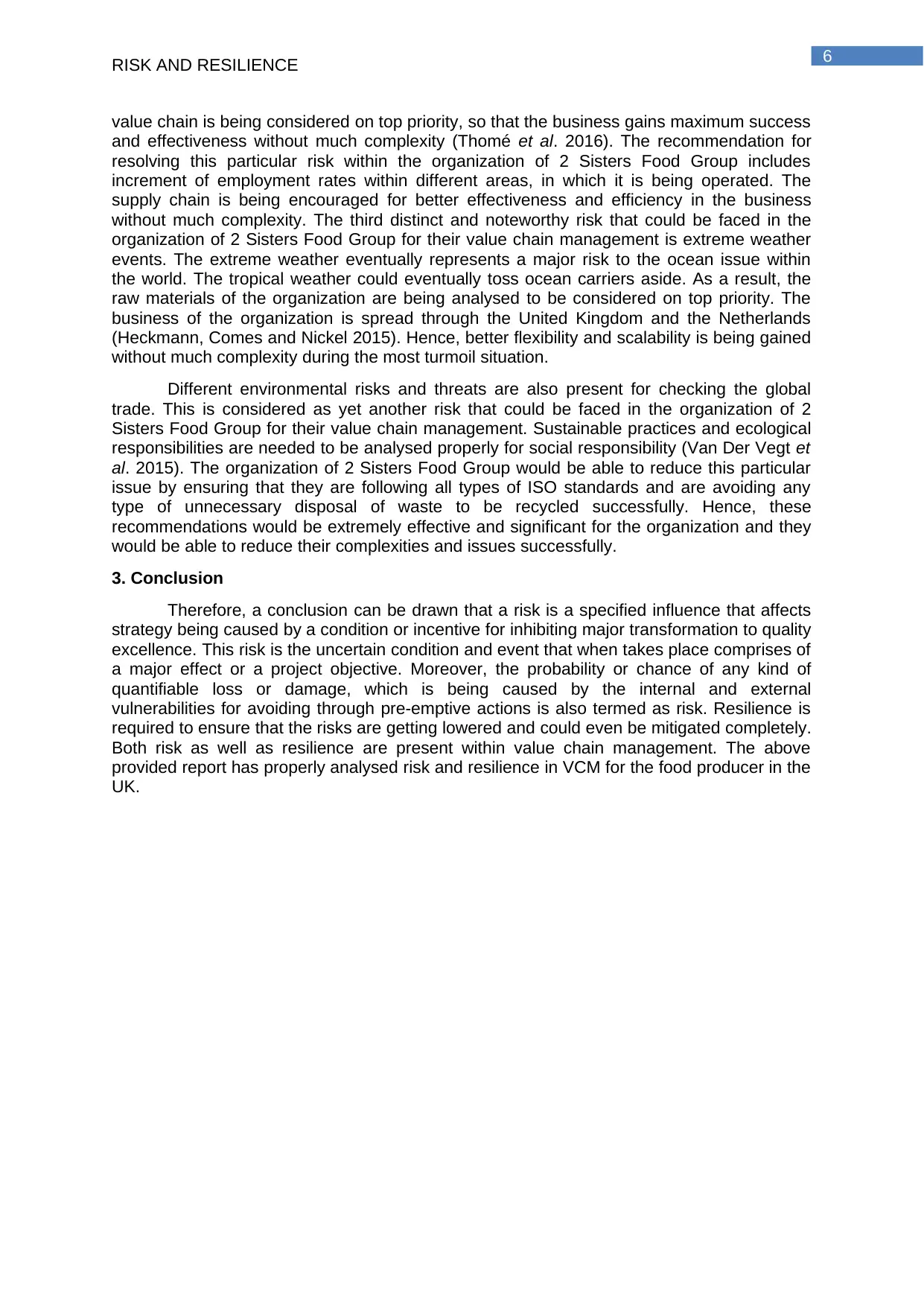
6
RISK AND RESILIENCE
value chain is being considered on top priority, so that the business gains maximum success
and effectiveness without much complexity (Thomé et al. 2016). The recommendation for
resolving this particular risk within the organization of 2 Sisters Food Group includes
increment of employment rates within different areas, in which it is being operated. The
supply chain is being encouraged for better effectiveness and efficiency in the business
without much complexity. The third distinct and noteworthy risk that could be faced in the
organization of 2 Sisters Food Group for their value chain management is extreme weather
events. The extreme weather eventually represents a major risk to the ocean issue within
the world. The tropical weather could eventually toss ocean carriers aside. As a result, the
raw materials of the organization are being analysed to be considered on top priority. The
business of the organization is spread through the United Kingdom and the Netherlands
(Heckmann, Comes and Nickel 2015). Hence, better flexibility and scalability is being gained
without much complexity during the most turmoil situation.
Different environmental risks and threats are also present for checking the global
trade. This is considered as yet another risk that could be faced in the organization of 2
Sisters Food Group for their value chain management. Sustainable practices and ecological
responsibilities are needed to be analysed properly for social responsibility (Van Der Vegt et
al. 2015). The organization of 2 Sisters Food Group would be able to reduce this particular
issue by ensuring that they are following all types of ISO standards and are avoiding any
type of unnecessary disposal of waste to be recycled successfully. Hence, these
recommendations would be extremely effective and significant for the organization and they
would be able to reduce their complexities and issues successfully.
3. Conclusion
Therefore, a conclusion can be drawn that a risk is a specified influence that affects
strategy being caused by a condition or incentive for inhibiting major transformation to quality
excellence. This risk is the uncertain condition and event that when takes place comprises of
a major effect or a project objective. Moreover, the probability or chance of any kind of
quantifiable loss or damage, which is being caused by the internal and external
vulnerabilities for avoiding through pre-emptive actions is also termed as risk. Resilience is
required to ensure that the risks are getting lowered and could even be mitigated completely.
Both risk as well as resilience are present within value chain management. The above
provided report has properly analysed risk and resilience in VCM for the food producer in the
UK.
RISK AND RESILIENCE
value chain is being considered on top priority, so that the business gains maximum success
and effectiveness without much complexity (Thomé et al. 2016). The recommendation for
resolving this particular risk within the organization of 2 Sisters Food Group includes
increment of employment rates within different areas, in which it is being operated. The
supply chain is being encouraged for better effectiveness and efficiency in the business
without much complexity. The third distinct and noteworthy risk that could be faced in the
organization of 2 Sisters Food Group for their value chain management is extreme weather
events. The extreme weather eventually represents a major risk to the ocean issue within
the world. The tropical weather could eventually toss ocean carriers aside. As a result, the
raw materials of the organization are being analysed to be considered on top priority. The
business of the organization is spread through the United Kingdom and the Netherlands
(Heckmann, Comes and Nickel 2015). Hence, better flexibility and scalability is being gained
without much complexity during the most turmoil situation.
Different environmental risks and threats are also present for checking the global
trade. This is considered as yet another risk that could be faced in the organization of 2
Sisters Food Group for their value chain management. Sustainable practices and ecological
responsibilities are needed to be analysed properly for social responsibility (Van Der Vegt et
al. 2015). The organization of 2 Sisters Food Group would be able to reduce this particular
issue by ensuring that they are following all types of ISO standards and are avoiding any
type of unnecessary disposal of waste to be recycled successfully. Hence, these
recommendations would be extremely effective and significant for the organization and they
would be able to reduce their complexities and issues successfully.
3. Conclusion
Therefore, a conclusion can be drawn that a risk is a specified influence that affects
strategy being caused by a condition or incentive for inhibiting major transformation to quality
excellence. This risk is the uncertain condition and event that when takes place comprises of
a major effect or a project objective. Moreover, the probability or chance of any kind of
quantifiable loss or damage, which is being caused by the internal and external
vulnerabilities for avoiding through pre-emptive actions is also termed as risk. Resilience is
required to ensure that the risks are getting lowered and could even be mitigated completely.
Both risk as well as resilience are present within value chain management. The above
provided report has properly analysed risk and resilience in VCM for the food producer in the
UK.
Paraphrase This Document
Need a fresh take? Get an instant paraphrase of this document with our AI Paraphraser
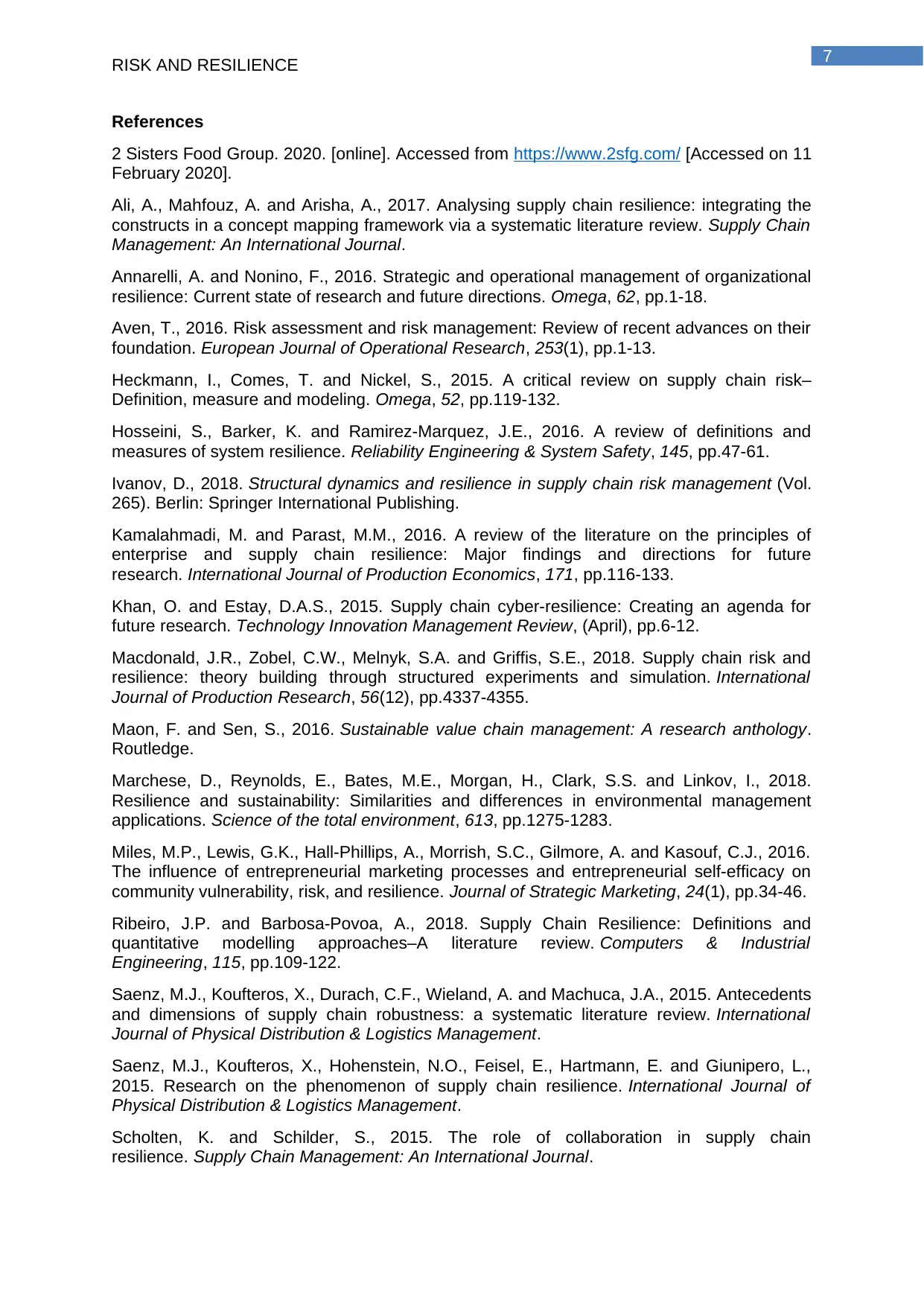
7
RISK AND RESILIENCE
References
2 Sisters Food Group. 2020. [online]. Accessed from https://www.2sfg.com/ [Accessed on 11
February 2020].
Ali, A., Mahfouz, A. and Arisha, A., 2017. Analysing supply chain resilience: integrating the
constructs in a concept mapping framework via a systematic literature review. Supply Chain
Management: An International Journal.
Annarelli, A. and Nonino, F., 2016. Strategic and operational management of organizational
resilience: Current state of research and future directions. Omega, 62, pp.1-18.
Aven, T., 2016. Risk assessment and risk management: Review of recent advances on their
foundation. European Journal of Operational Research, 253(1), pp.1-13.
Heckmann, I., Comes, T. and Nickel, S., 2015. A critical review on supply chain risk–
Definition, measure and modeling. Omega, 52, pp.119-132.
Hosseini, S., Barker, K. and Ramirez-Marquez, J.E., 2016. A review of definitions and
measures of system resilience. Reliability Engineering & System Safety, 145, pp.47-61.
Ivanov, D., 2018. Structural dynamics and resilience in supply chain risk management (Vol.
265). Berlin: Springer International Publishing.
Kamalahmadi, M. and Parast, M.M., 2016. A review of the literature on the principles of
enterprise and supply chain resilience: Major findings and directions for future
research. International Journal of Production Economics, 171, pp.116-133.
Khan, O. and Estay, D.A.S., 2015. Supply chain cyber-resilience: Creating an agenda for
future research. Technology Innovation Management Review, (April), pp.6-12.
Macdonald, J.R., Zobel, C.W., Melnyk, S.A. and Griffis, S.E., 2018. Supply chain risk and
resilience: theory building through structured experiments and simulation. International
Journal of Production Research, 56(12), pp.4337-4355.
Maon, F. and Sen, S., 2016. Sustainable value chain management: A research anthology.
Routledge.
Marchese, D., Reynolds, E., Bates, M.E., Morgan, H., Clark, S.S. and Linkov, I., 2018.
Resilience and sustainability: Similarities and differences in environmental management
applications. Science of the total environment, 613, pp.1275-1283.
Miles, M.P., Lewis, G.K., Hall-Phillips, A., Morrish, S.C., Gilmore, A. and Kasouf, C.J., 2016.
The influence of entrepreneurial marketing processes and entrepreneurial self-efficacy on
community vulnerability, risk, and resilience. Journal of Strategic Marketing, 24(1), pp.34-46.
Ribeiro, J.P. and Barbosa-Povoa, A., 2018. Supply Chain Resilience: Definitions and
quantitative modelling approaches–A literature review. Computers & Industrial
Engineering, 115, pp.109-122.
Saenz, M.J., Koufteros, X., Durach, C.F., Wieland, A. and Machuca, J.A., 2015. Antecedents
and dimensions of supply chain robustness: a systematic literature review. International
Journal of Physical Distribution & Logistics Management.
Saenz, M.J., Koufteros, X., Hohenstein, N.O., Feisel, E., Hartmann, E. and Giunipero, L.,
2015. Research on the phenomenon of supply chain resilience. International Journal of
Physical Distribution & Logistics Management.
Scholten, K. and Schilder, S., 2015. The role of collaboration in supply chain
resilience. Supply Chain Management: An International Journal.
RISK AND RESILIENCE
References
2 Sisters Food Group. 2020. [online]. Accessed from https://www.2sfg.com/ [Accessed on 11
February 2020].
Ali, A., Mahfouz, A. and Arisha, A., 2017. Analysing supply chain resilience: integrating the
constructs in a concept mapping framework via a systematic literature review. Supply Chain
Management: An International Journal.
Annarelli, A. and Nonino, F., 2016. Strategic and operational management of organizational
resilience: Current state of research and future directions. Omega, 62, pp.1-18.
Aven, T., 2016. Risk assessment and risk management: Review of recent advances on their
foundation. European Journal of Operational Research, 253(1), pp.1-13.
Heckmann, I., Comes, T. and Nickel, S., 2015. A critical review on supply chain risk–
Definition, measure and modeling. Omega, 52, pp.119-132.
Hosseini, S., Barker, K. and Ramirez-Marquez, J.E., 2016. A review of definitions and
measures of system resilience. Reliability Engineering & System Safety, 145, pp.47-61.
Ivanov, D., 2018. Structural dynamics and resilience in supply chain risk management (Vol.
265). Berlin: Springer International Publishing.
Kamalahmadi, M. and Parast, M.M., 2016. A review of the literature on the principles of
enterprise and supply chain resilience: Major findings and directions for future
research. International Journal of Production Economics, 171, pp.116-133.
Khan, O. and Estay, D.A.S., 2015. Supply chain cyber-resilience: Creating an agenda for
future research. Technology Innovation Management Review, (April), pp.6-12.
Macdonald, J.R., Zobel, C.W., Melnyk, S.A. and Griffis, S.E., 2018. Supply chain risk and
resilience: theory building through structured experiments and simulation. International
Journal of Production Research, 56(12), pp.4337-4355.
Maon, F. and Sen, S., 2016. Sustainable value chain management: A research anthology.
Routledge.
Marchese, D., Reynolds, E., Bates, M.E., Morgan, H., Clark, S.S. and Linkov, I., 2018.
Resilience and sustainability: Similarities and differences in environmental management
applications. Science of the total environment, 613, pp.1275-1283.
Miles, M.P., Lewis, G.K., Hall-Phillips, A., Morrish, S.C., Gilmore, A. and Kasouf, C.J., 2016.
The influence of entrepreneurial marketing processes and entrepreneurial self-efficacy on
community vulnerability, risk, and resilience. Journal of Strategic Marketing, 24(1), pp.34-46.
Ribeiro, J.P. and Barbosa-Povoa, A., 2018. Supply Chain Resilience: Definitions and
quantitative modelling approaches–A literature review. Computers & Industrial
Engineering, 115, pp.109-122.
Saenz, M.J., Koufteros, X., Durach, C.F., Wieland, A. and Machuca, J.A., 2015. Antecedents
and dimensions of supply chain robustness: a systematic literature review. International
Journal of Physical Distribution & Logistics Management.
Saenz, M.J., Koufteros, X., Hohenstein, N.O., Feisel, E., Hartmann, E. and Giunipero, L.,
2015. Research on the phenomenon of supply chain resilience. International Journal of
Physical Distribution & Logistics Management.
Scholten, K. and Schilder, S., 2015. The role of collaboration in supply chain
resilience. Supply Chain Management: An International Journal.
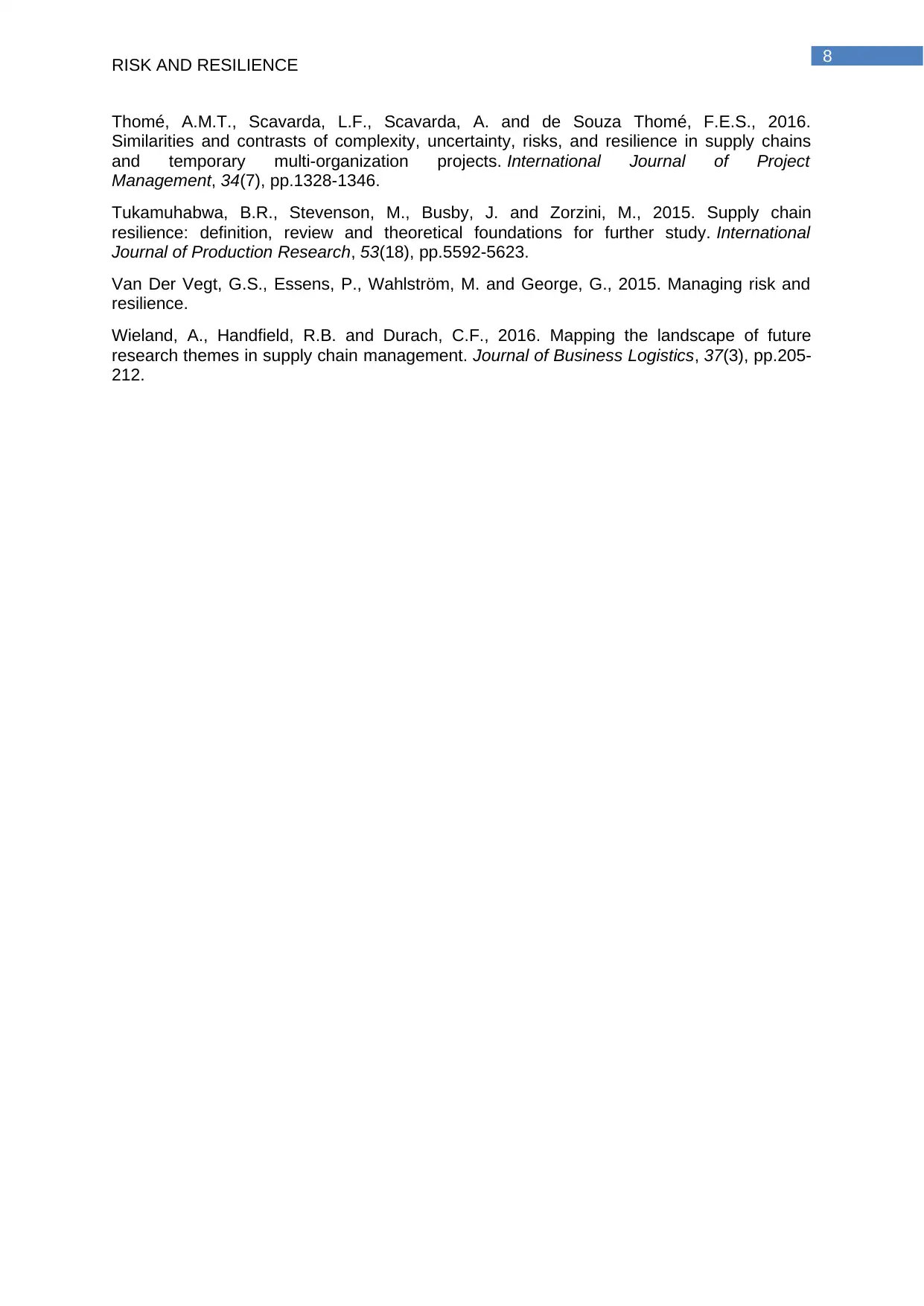
8
RISK AND RESILIENCE
Thomé, A.M.T., Scavarda, L.F., Scavarda, A. and de Souza Thomé, F.E.S., 2016.
Similarities and contrasts of complexity, uncertainty, risks, and resilience in supply chains
and temporary multi-organization projects. International Journal of Project
Management, 34(7), pp.1328-1346.
Tukamuhabwa, B.R., Stevenson, M., Busby, J. and Zorzini, M., 2015. Supply chain
resilience: definition, review and theoretical foundations for further study. International
Journal of Production Research, 53(18), pp.5592-5623.
Van Der Vegt, G.S., Essens, P., Wahlström, M. and George, G., 2015. Managing risk and
resilience.
Wieland, A., Handfield, R.B. and Durach, C.F., 2016. Mapping the landscape of future
research themes in supply chain management. Journal of Business Logistics, 37(3), pp.205-
212.
RISK AND RESILIENCE
Thomé, A.M.T., Scavarda, L.F., Scavarda, A. and de Souza Thomé, F.E.S., 2016.
Similarities and contrasts of complexity, uncertainty, risks, and resilience in supply chains
and temporary multi-organization projects. International Journal of Project
Management, 34(7), pp.1328-1346.
Tukamuhabwa, B.R., Stevenson, M., Busby, J. and Zorzini, M., 2015. Supply chain
resilience: definition, review and theoretical foundations for further study. International
Journal of Production Research, 53(18), pp.5592-5623.
Van Der Vegt, G.S., Essens, P., Wahlström, M. and George, G., 2015. Managing risk and
resilience.
Wieland, A., Handfield, R.B. and Durach, C.F., 2016. Mapping the landscape of future
research themes in supply chain management. Journal of Business Logistics, 37(3), pp.205-
212.
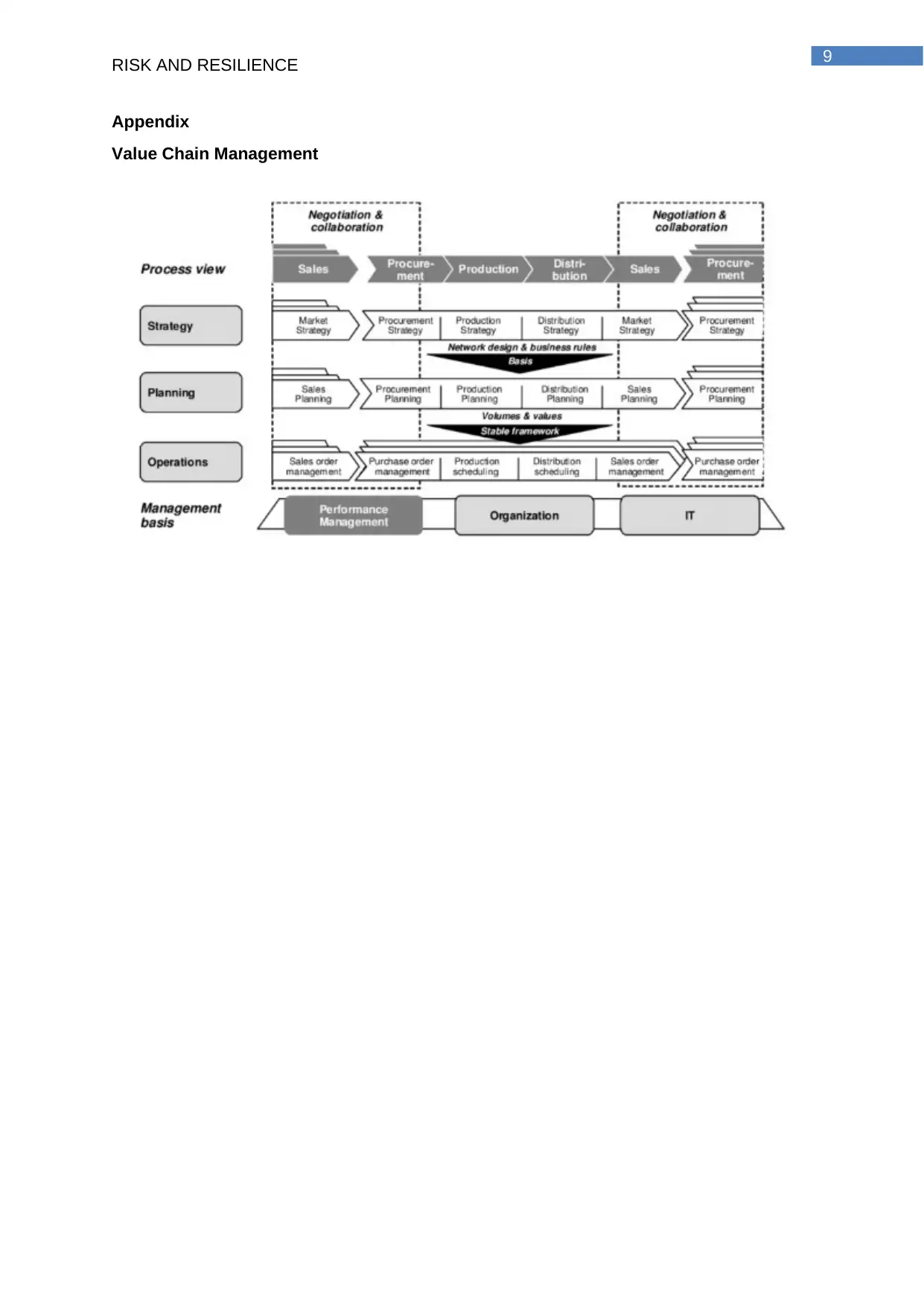
9
RISK AND RESILIENCE
Appendix
Value Chain Management
RISK AND RESILIENCE
Appendix
Value Chain Management
1 out of 10
Related Documents
Your All-in-One AI-Powered Toolkit for Academic Success.
+13062052269
info@desklib.com
Available 24*7 on WhatsApp / Email
![[object Object]](/_next/static/media/star-bottom.7253800d.svg)
Unlock your academic potential
© 2024 | Zucol Services PVT LTD | All rights reserved.





